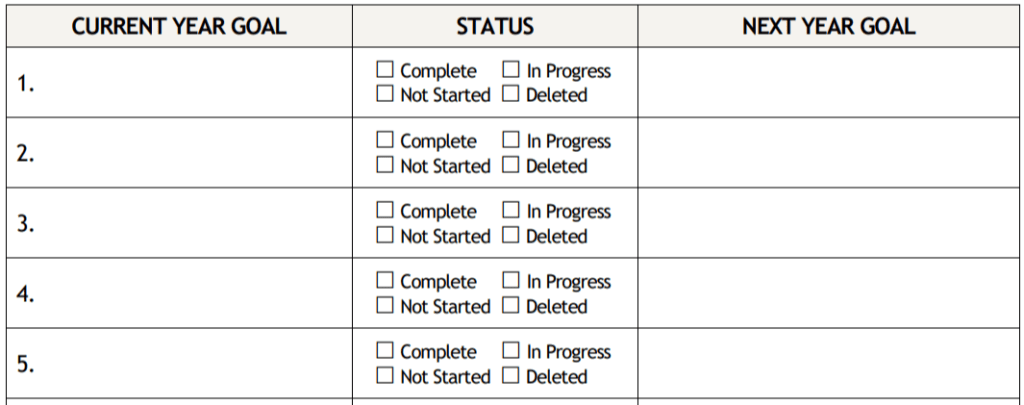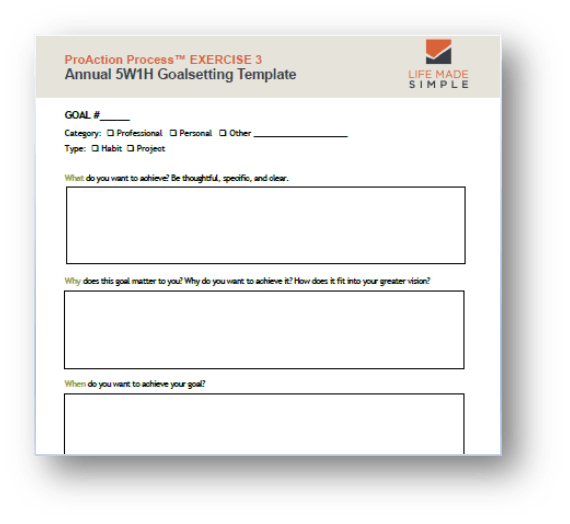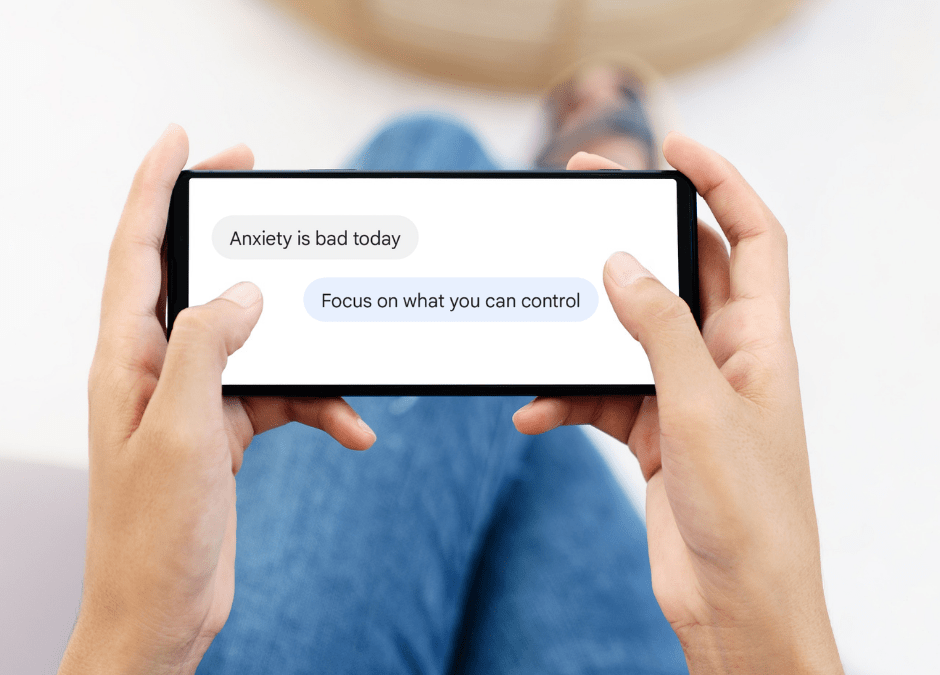
by Lori Vande Krol | Dec 19, 2022 | General Productivity, Goals and Priorities, Habits, Planning, Time Management
How has 2022 been for you? What went well? What could be improved? Did you reach your business and life goals? What will you do differently next year to grow further?
Before you do 2023 annual planning, it is a valuable exercise to close out the year and prepare for the new one by reviewing your goals, habits, and routines. Follow the steps below to review and reset for continued success.
1. Reflect
Look back on the past year and answer reflection questions such as:
- What did I accomplish this year?
- What am I proud of?
- What am I thankful for?
- What should I celebrate?
- What will I continue to do that contributed to my success?
- What were my challenges this year?
- What could/would I have done differently?
- What is one thing I could do to improve next year?
Set aside focused time to write your answers to these questions. You may be surprised at what you learn about yourself, your systems and habits, and how to address challenges in the upcoming year.
For example, during my Year in Review, I realized I am not diligent about scheduling time into my calendar at the beginning of each week for the “important but not urgent” tasks and projects. I, therefore, have not made the progress I wanted on many of these projects. I need to create a routine of setting aside time each week, just as I do with my exercise, before I build in other tasks and appointments. This will now be part of my planning process for 2023.
2. Review Your Annual Goals
The second step in your Year in Review is to review the status of your current year annual goals – both professional and personal. What goals are complete? What contributed to that success? Do you have goals that are not complete, or were not even started? If so, what challenges prevented their completion? Or perhaps there was a change in priority or focus during the year. Determine which of these goals should remain for the upcoming year and write any notes to carry into your 2023 annual goal setting.

3. Analyze Your Habits and Routines
How did you do on your goals and progress related to your defined habits this year? Review your habit tracking tables and schedule time to reward yourself for any goals reached. Will these habits continue or grow?
For those habits that were a struggle, analyze the reasons and what needs to change in the upcoming year. Do you understand the deeper “why” for the habit? Do you have the right tools in place? Do you need an accountability partner or coach? Determine the habits you will stop, continue, or update for the upcoming year.
Similarly, review your current routines (or routines you had hoped to establish this year). Look at your morning, start of day, end of day, and evening routines. How are they working for you? Do they need to be adjusted or reset? Establish the routines you would like to implement in 2023.
To help you with your Year In Review, I have created a downloadable template to walk you through the process. Click below to have it emailed to you.
Year in Review Template
FREE DOWNLOAD
You can also find this template, along with other valuable planning exercises and templates, at ProActionPlanner.com. Get them soon as they will only be free until the of the year.
If you’d like assistance with review and reflection, the goal-setting process, or in setting up systems for success, contact Lori at Life Made Simple or schedule your free 30-minute consultation. I’d love to help!

by Lori Vande Krol | Jun 22, 2022 | General Productivity, Goals and Priorities, Motivation, Procrastination, Team Productivity, Time Management
I have a confession to make. Months went by this year before I finally took focused time to set my annual goals. While I help others to do this daily and understand the importance and benefit of annual goal setting, I was not able to complete the task for myself. I took some time to reflect on my reasons for procrastinating on this task, which helped me to work through and complete the process. Following are a few reasons you might find goal setting difficult as well as some tips and resources to make it simpler.
1. The goal, outcome, or supporting actions, are unclear.
Too many times, I have gotten hung up on taking action because the end result, or the full range of steps I need to take to get there, is not completely clear. I have to remind myself that taking some action is better than nothing at all. Often, as you start to take action the goal and end result becomes clearer.
In his article, The Goal is Not the Point, James Clear says: ” In other words, your goal becomes your compass, not your buried treasure. The goal is your direction, not your destination. The goal is a mission that you are on, a path that you follow. Whatever comes from that path—whatever treasure you happen to find along this journey—well, that’s just fine. It is the commitment to walking the path that matters.”
When the goal or destination is not clear, consider your goal a direction you are heading, and clarify the end result as you go.
2. Setting big goals is scary.
There are many fears that can hold us back from setting and achieving goals. “What if I fail?” or “What if I succeed? Can I handle it? What comes next?” Perhaps it is a fear of change or a fear of losing control that is holding you back. In times like this, you must ask yourself, “What happens if I don’t try?”
Are you willing to live with more of the same? The status quo? Or are you willing to accept some risks and potential challenges in order to grow and achieve more? What great things might happen, for yourself and others, if you succeed? Take time to evaluate your fears. Learn what is driving the fear and anxiety in order to push forward. You may find that you even enjoy the journey.
3. Goal setting has not been successful in the past.
Last fall I was presenting a course on procrastination. When discussing potential reasons for procrastination, I shared that we often fail to take action when the end goal is unclear. An attendee raised her hand and asked, “What is the point of setting goals? It never works.” I challenged her to think more deeply about her hesitation toward goalsetting. I asked if there was possibly something else holding her back. After the presentation, we talked further, and I learned that she had worked for large corporations most of her career. Those companies would go through the annual goalsetting process, but it would end there. Management would not follow through or follow up on the actions required to achieve those goals. Goals were not reviewed regularly. Employees were also unclear on how the company’s goals tied to their own vision and goals. The lack of a full system for goal setting and implementation caused it to fail, and employees no longer trusted the process.
If goal setting has not been successful for you in the past, reflect on the true reasons for this. What can be done differently to improve your chances of success? There are many tools and tips to support individual, team, and company goalsetting. The systems and processes used need to work for everyone involved. Below I share additional resources for successful goalsetting.
The potential reasons for avoiding the task of goal setting are not unlike the reasons for procrastinating any task. The first step is working to understand your unique reasons for avoidance and then to find the right tool and process for you and/or your team. There is no doubt you will grow and achieve more.
Additional Resources for Goal Setting
Goal Setting: A Scientific Guide to Setting and Achieving Goals by James Clear
Mastering Time Management: What To Do Before the To-Do List by Lori Vande Krol
Do You Have a Lot of Big Goals? Focus on What You Know and Love by Lori Vande Krol
The Superman: Goal Achieved by Lori Vande Krol
The ProAction Planner™: a system to turn your annual goals into action throughout the year
FREE DOWNLOAD: Use the button below to receive a free Annual Goal Setting Template

Annual 5W1H Goalsetting Template
FREE DOWNLOAD
It is not too late to set your annual goals for this year! If you’d like assistance with the goal-setting process, or in setting up systems for success, contact Lori at Life Made Simple or schedule your free 30-minute consultation. I’d love to help!

by Lori Vande Krol | Mar 3, 2022 | Goals and Priorities, Habits, Mental Health, Planning, Time Management
My daughter was recently feeling some anxiety at school and texted to let me know. One of the responses I texted back was to “focus on what you can control.” It had an impact, and she decided to post it on social media. The next day she told me it was her most shared post ever – it resonated with many of her followers.
Later that week, a coaching client shared a challenge she had encountered when an unexpected issue arose that stopped her in her tracks. It caused her stress and frustration and caused her to lose many hours of time. As we talked through her reaction to the situation, I asked her, “Looking back, what could you control about the situation at that moment?”, “What was the appropriate reaction?”, “What next steps did you take, or could you have taken?”
With so much out of our control on a daily basis, it’s important to control what we can, be intentional about our thoughts and choices, and act based on this. It’s not always easy but worrying about things we have no control over wastes time and energy and increases stress.
Below are a few tools you might consider to help you focus on those things you can control, so you can better cope with the unexpected and uncontrollable.
Plan
Do you often feel you are constantly reacting to the current “fire” or “squeaky wheel”? Some believe there is no use in planning if things are out of your control anyway. But, this is exactly the reason for it. Planning allows you to gain control over your time and actions in a proactive way. It gives you a better understanding of what is urgent and what is important. Then when the unexpected occurs you can more easily adjust and make intentional choices about if, and how, it fits into your plan. By planning you are making a habit of “focusing on what you can control.”
Stop and Think, Then Act
When the unexpected occurs, or you are feeling anxiety at a certain moment, step back from the situation and ask yourself the following questions:
-
- What can I control about this situation or about what I am feeling?
- Is this my worry or my challenge to handle or does it belong to someone else?
- What specific action(s) can I take to move forward?
Taking a moment to answer these questions will allow you to refocus and transition from being reactive to proactive, allowing for intentional choices about your next thoughts and actions.
Journal
If you are someone who best processes information by writing, take some time to journal your answers to the questions above. Journaling daily on anything that weighs on your mind is a great habit to develop to gain control over your thoughts and actions.
Meditate or Pray
Depending on your spiritual preference, tools such as meditation and prayer can help keep your mind focused and present, along with other benefits. Practicing regularly will help train your mind to react in a more relaxed and focused way when dealing with unexpected and challenging situations. There are many free apps that can help you learn and practice these techniques including Calm, Headspace, and Insight Timer.
What tools or techniques have you found to help you decrease anxiety and stress and focus on the things you can control? Share them in the comments below!

by Lori Vande Krol | Sep 1, 2021 | General Productivity, Goals and Priorities, Habits, Task and Project Management, Time Management
Recently on a beautiful Sunday afternoon, I decided to join my husband for a bike ride. We filled the tires and water bottles, put on our helmets, and headed out. I felt a little extra resistance while peddling up the hill out of our neighborhood and thought, “Ok, this is hard. I think I just need to warm up.” As we pedaled on, I continued to feel that the ride was much more difficult than I expected. I couldn’t keep up with my husband – it seemed even when he wasn’t peddling he was going faster than me – and I was already out of breath. Thoughts that were going through my head during this time included: “I thought I was in better shape than this.” “I work out more than him…why can’t I keep up?” “Is biking really that different than my regular workout?” “What is wrong with me?”
After over three miles of this, it was time to turn back for home. We stopped so I could catch my breath and get a drink of water and my husband said, “Are you sure there isn’t something wrong with your bike? Maybe your tires?” I responded that it felt like it was riding fine and I didn’t hear any strange noises or rubbing, but let me get off my bike and check just to be sure. Lo and behold, the front brake was snug against the tire. I had basically been riding with the brakes on! After a few minutes, I figured out the problem, fixed it, and we rode home in about half the time it took us to get there – a much more enjoyable ride.
What does this somewhat embarrassing story have to do with productivity?
How many times in your life are you pushing against some sort of friction without realizing it? What could be made easier and more enjoyable if you stepped back and really analyzed, and addressed the issue? Often, we are so engrossed in day-to-day life, information, and tasks that we fail to really consider what we are doing. It is vital that we regularly take time to review and reset. In his book Essentialism: The Disciplined Pursuit of Less, Greg McKeown asks “Is there a point at which doing less (but thinking more) will actually produce better outcomes?” My response is “yes”! And my sore legs would agree.
Below are three simple steps you can take to minimize or alleviate the friction in your life and career.
1. Take Notice
Pablo Picasso said, “Without great solitude, no serious work is possible.” It is important to take focused time regularly to review your actions. Are they intentional? Do they reflect your priorities? Are you in control or are you letting others define your schedule and tasks? Are there processes, projects, or tasks that could be done more efficiently or effectively? A regular review might include the following questions:
- What is going well for me? How can I continue this?
- What do I not enjoy? What are my challenges? What can I stop doing? What can be made simpler?
- What do I most enjoy? What do I look forward to? How can I do more of this? What might get in the way?
This reflection is much easier to do if you are clear on your vision, priorities, and plan. For more on this, see my June 2021 blog, Mastering Time Management: What To Do Before the To Do List.
2. Identify the Issue
When you take focused time to reflect and review your priorities and related actions, it becomes simpler to identify any issues that are holding you back, getting in your way, or causing unnecessary friction. Maybe it’s a process, tool, or system that isn’t working optimally. Perhaps a colleague, friend, or family member is causing tension or stress. Or maybe it’s the position, company, or career you are in. It may even be a medical issue that has been overlooked resulting in lower productivity, and higher stress and anxiety.
If you are reviewing systems and processes for a company or team, identifying issues can entail a full-blown workflow analysis to find areas for automation, unneeded duplication, or improvements to technology, training, and communication. More often though, it just takes quiet, focused thought or journaling to pinpoint obstacles towards reaching your goals. Identify them and write them down.
3. Create Change
How will you minimize or alleviate the issues you have identified above? Consider any resources needed to support the change as well as your own habits or actions that need to change. What will you do differently going forward to reduce the friction or obstacles keeping you from success and enjoyment? Making a full plan for success is great, but sometimes you’ll need to just start with one small action step. Then, take another and another. Change can be hard, but the increased joy and success will be well worth it. And, you will likely reach your goals much quicker than you would have otherwise.
As my husband and I drove our bikes back into the garage, we found our daughter waiting for us to leave for her soccer game. Since the bike ride took much longer than expected, we were almost late. I realized then how much the friction I was working against for the first half of the ride impacted more than just me. It also caused stress for my daughter and potentially her team and coach if we were late. While I wish I would have stopped to evaluate the situation sooner, the fact that I did eventually stop to (1) take notice, (2) identify the issue with the brakes, and (3) create change by working to fix it, allowed for a much more enjoyable ride home, and we arrived at pre-game warm-up just in time.

by Lori Vande Krol | Jun 25, 2021 | Goals and Priorities, Task and Project Management, Time Management
You are constantly presented with new information, communications, to-dos, and ideas. At any point in time, you have hundreds of options for how you choose to spend that moment. While it may feel good to check things off a to-do list, if you aren’t intentional about what is on your to-do list or in your schedule, as well as the choices you make throughout the day, you are not productively working towards goals but instead just “being active.” This can eventually lead to feeling drained, overwhelmed, directionless, and even a sense of failure.
Oxford Dictionaries defines time management as “the ability to use one’s time effectively or productively, especially at work.” But you are only managing your time effectively if you are spending it on the right things, i.e. those tasks and activities that support your greater vision and goals. This starts with knowing what is important and where you want to go. Then, you can better define your shorter-term goals, ensure your actions relate to and support those goals, and achieve the success and happiness you desire. Let’s break this down.
Step 1: Know What is Important and Where You Want To Go
If you aren’t clear about what is important in your life and work, you will likely be overwhelmed and unsure if you’re using your time in the most optimal way. All of the planners, apps, and products in the world can’t help you if you don’t know your priorities.
In order to create the needed clarity, the first step is to determine your long-term vision for work and life. If this is an exercise you haven’t done before, it can be difficult but eye-opening. Start by setting aside some focused time to write your answers to the following questions:
- What do I love about my life right now? What do I enjoy doing? What am I good at?
- How can I do more of this?
- What do I spend time on now that I don’t enjoy?
- How can I do less of this?
- What would I like to do that I am not currently doing?
- Where would I like to see myself in 5 or 10 years? Where am I? What am I doing? Who am I spending time with? What does success look like to me?
- What do I want to contribute to the world?
Once you have written your answers, circle words or phrases that stand out to you the most. Use these words and phrases to draft a few sentences defining your vision and priorities over the next 5-10 years. Don’t worry if it isn’t perfect, and know that it may change a little from year to year. What is important is that you have been thoughtful and intentional about your vision and high-level priorities as you see them right now.
Step 2: Turn Your Long-Term Vision into Short-Term Goals
Once you’re clear on your priorities and vision for success and happiness, you can now set shorter-term goals and objectives. Using your vision statement from above as a basis, determine what you will do in the upcoming year to support your long-term vision for success. In other words, create your SMART Goals* for the upcoming year. (You might categorize these goals by area of work and/or life.)
Then for each goal, answer the following questions:
- What resources do I need?
- Who can help?
- What might get in the way of success and how can I address it?
Document your goals on paper, in a spreadsheet, word document, or in a project planning tool. Once you are clear on your annual goals, you can then determine the strategies needed to reach each goal. In other words, how will you reach your goals by the desired dates? If your goal is to lose 20 lbs by the end of the year, your strategies may be to exercise at least three times per week, learn and implement meal planning, and hire a wellness coach.
Step 3: Determine Goal-Based Next Actions
With annual goals and strategies in place, you can now determine the specific actions required to support them. Don’t worry if you can’t yet list every action needed throughout the year. Focus first on the upcoming quarter, or at least the next 1-3 actions needed to make progress towards your goal. Once these actions are complete, the following steps should become clearer. In the weight-loss example above, the first three actions might be to: 1. Purchase a gym membership, 2. Research potential meal planning programs, and 3. Set up interviews with 3 wellness coaches.
With specific next actions defined to support your goals, strategies, and long-term vision, you are NOW ready to plan and schedule these actions into your weeks and days. The tools and strategies you use for weekly planning and scheduling may vary depending on your job, your work style, your specific challenges, and personal preferences. Check out my blog or follow me on social media for guidance and tips related to weekly planning and other daily time mastery tips.
Step 4: Review and Reset
It is important to periodically review, and potentially reset, your annual goals and objectives as well as your long-term vision. This will help you continue to work with intention, stay focused, and achieve more. When you face obstacles, it will help you remember your “why” and keep you motivated to continue.
The time you spend on this process will help to ensure you are spending your time, energy, and focus on the right things each day. You will have more control over your time and feel less stress and greater joy.
*SMART Goals are: Specific, Measurable, Attainable, Relevant, and Time-Based

by Lori Vande Krol | Feb 24, 2021 | Goals and Priorities, Meetings, Team Productivity, Technology, Time Management
The availability and ease of Zoom and other virtual technology has been one of the bright sides of this past year. Without it, we wouldn’t be able to see our colleagues and friends while working safely at home, continuing education opportunities would be minimal, grandparents may not see their grandchildren whether it be a few miles or thousands of miles away, and those sick in the hospital may not be able to see their family. One of my favorite things about virtual calls during Covid is being able to see full faces instead of masked ones. But, according to a recent study done by Stanford University professor Jeremy Bailenson, founding director of the Stanford Virtual Human Interaction Lab, being in these virtual meetings throughout your day can lead to exhaustion and may even increase stress.
The Mercury News summarizes the findings and suggestions from Professor Bailenson’s study, which addresses Zoom Fatigue from a technical and physical perspective. Here I share three additional ways we can minimize this stress and exhaustion from the standpoint of planning and productivity.
Be Intentional About Holding a Virtual Meeting
If you are the one initiating the meeting, determine whether the meeting is absolutely necessary and if so, if virtual is the most appropriate format. Would a phone call or conference call work just as well? Or is the topic something that could be handled quickly over email or chat?
If you have been invited to a virtual meeting or webinar, determine whether it is necessary for you to attend. What value will you receive? What will you add to the meeting? Be intentional about your choices.
Block “Meeting Days” and Add Breaks
If you have been intentional about the meetings you attend and it is still necessary for you to have several meetings a week, try to hold meetings on the same day as much as possible. While you may still have some Zoom fatigue at the end of that day, the benefits of one or two meeting-free days are great. You will be able to focus for longer periods of time with fewer interruptions and without the nagging feeling in the back of your mind that you need to remember to log in at a certain time. You’ll also save a little time on those days you don’t have to be “Zoom ready.”
When you schedule several meetings on the same day, be sure to leave a little time between them – I suggest 30 minutes. This allows a cushion in case the meeting runs over and also gives you time to review your notes, clarify and schedule next actions, and reset before the next meeting. Be sure to leave a few minutes to get up, move around, and refill your water.
Meeting Standards Don’t Change in a Virtual Setting
Standards and guidelines for a video meeting should be the same as an in-person meeting (except that sweatpants or leggings and a quiet pet in the background is perfectly acceptable). Someone should be responsible for the agenda, make sure that everyone has the materials they need ahead of time, and assign a leader to keep the meeting on track. Also, don’t end the meeting without full clarity regarding next actions and who is responsible. Learn the 5 key steps to an effective meeting.
I also recommend allowing a few minutes at the beginning of the meeting to check in with everyone. It’s been a tough year, and we could all use a little reassurance, support, and reminder that we’re all in this together.









Recent Comments